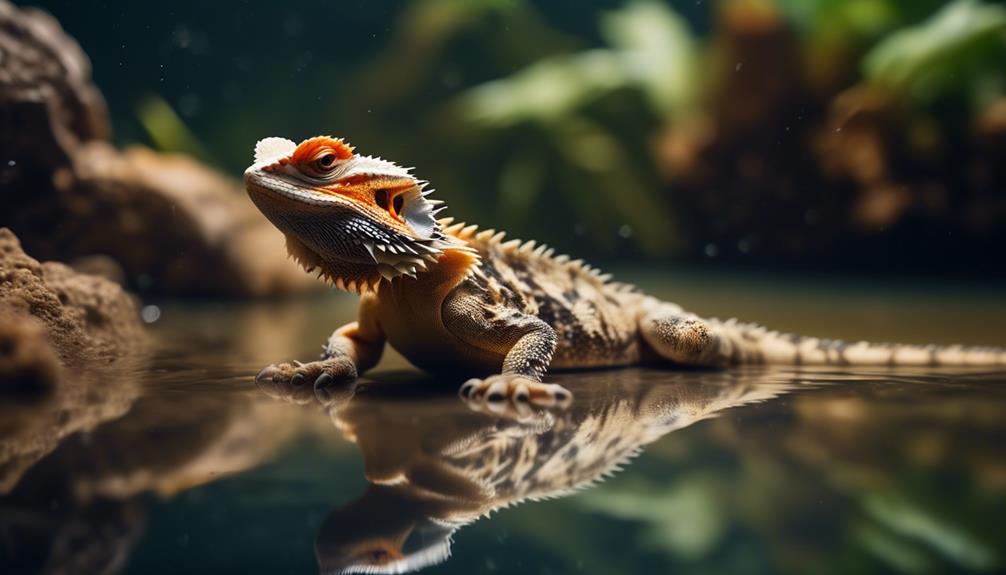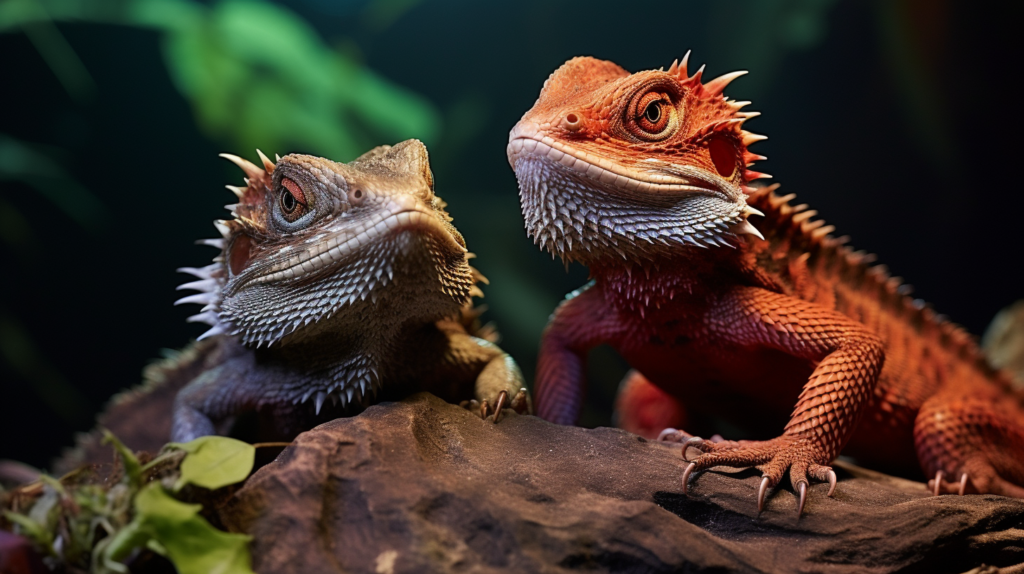Have you ever wondered if bearded dragons are naturally drawn to water? While these creatures are often associated with the dry, arid deserts of Australia, their relationship with swimming is a topic of interest among reptile enthusiasts.
Understanding the behavior and preferences of bearded dragons when it comes to water can provide valuable insights into their overall well-being. As you explore this topic, you may be surprised by the fascinating ways in which these reptiles interact with aquatic environments and the considerations that come with introducing them to swimming experiences.
Key Takeaways
- Bearded dragons are native to arid and semi-arid regions in Australia and have adapted to cope with water scarcity.
- They obtain most of their water from the food they consume and have specialized skin to minimize water loss.
- Bearded dragons exhibit impressive limb articulation, quick reflexes, and muscular, prehensile tails, which are essential for their daily activities and survival.
- When introducing bearded dragons to swimming, it's important to do so gradually, monitor their behavior closely, and provide a suitable swimming environment with the right water temperature and safety measures.
Bearded Dragon Natural Habitat
In their natural habitat, bearded dragons typically inhabit the arid and semi-arid regions of Australia, preferring areas with rocky terrain and sparse vegetation. The desert environment poses challenges such as high temperatures and water scarcity, to which these reptiles have adapted ingenious survival techniques. Bearded dragons have evolved to thrive in these harsh conditions through behavioral and physiological adaptations.
To cope with water scarcity in their habitat, bearded dragons have developed several survival strategies. They obtain most of their water from the food they consume, which primarily consists of insects, vegetation, and the occasional small mammal. This adaptation allows them to minimize their need for direct water consumption. Additionally, they've specialized skin that minimizes water loss, enabling them to endure the arid conditions of their environment. Their ability to efficiently extract moisture from their food and conserve water makes them well-suited to their desert habitat.
Behaviorally, bearded dragons have adapted to their environment by being most active during the early morning and late afternoon, avoiding the extreme heat of midday. They also utilize their surroundings for thermoregulation, basking on rocks to absorb heat and retreating to shade to avoid overheating. These behaviors optimize their chances of survival in the desert environment by minimizing water loss and avoiding excessive heat exposure.
Understanding these adaptations is crucial for providing suitable care to bearded dragons in captivity, mimicking their natural habitat as closely as possible.
Bearded Dragon Physical Abilities
Adapted to survive in their arid habitat, bearded dragons possess remarkable physical abilities that enable them to thrive in challenging environmental conditions. These reptiles are known for their agility and ability to undertake reptile exercise, which is essential for their overall well-being. Below is a table illustrating some of the physical abilities that make bearded dragons such fascinating creatures.
| Physical Ability | Description | Importance |
|---|---|---|
| Limb Articulation | Bearded dragons exhibit impressive limb articulation, allowing them to climb, dig, and bask effectively. | Essential for their daily activities and thermoregulation. |
| Tail Functionality | Their tails are muscular and prehensile, aiding in balance, agility, and even grasping objects. | Crucial for climbing, leaping, and navigating their surroundings. |
| Quick Reflexes | These reptiles possess remarkable reflexes, enabling them to swiftly capture prey and avoid predators. | Vital for hunting, self-defense, and survival in the wild. |
The adaptability and agility of bearded dragons make them captivating creatures to observe. Understanding the physical abilities of these lizards is crucial for providing them with an environment that supports their natural behaviors and promotes their well-being. It's truly remarkable to witness the agility and grace with which these reptiles move, demonstrating the incredible capabilities they have evolved to possess.
Bearded Dragon Behavior in Water
With occasional reluctance, bearded dragons may exhibit varying degrees of behavior in water, displaying a range of responses from hesitation to a natural inclination for aquatic activities. When it comes to water temperature, bearded dragons generally prefer temperatures between 85-100°F (29-38°C) for swimming. Water that's too cold may cause them to become stressed, while water that's too hot can lead to overheating. It's important to monitor the water temperature closely to ensure it falls within the optimal range for your bearded dragon's comfort and safety.
Behavioral indicators can provide insight into a bearded dragon's comfort level in water. Some dragons may initially display hesitation or discomfort when introduced to water, often seen through body language such as stiffening of the legs or tail. However, with time and positive experiences, they may become more relaxed and even begin to enjoy swimming. On the other hand, some bearded dragons may naturally exhibit a fondness for water, displaying excitement and eagerness when presented with the opportunity to swim.
It's crucial to introduce bearded dragons to water gradually and patiently, allowing them to acclimate at their own pace. Always supervise them closely while in water to ensure their safety. By observing their behavioral cues and providing appropriate water temperature, you can help create a positive and enjoyable experience for your bearded dragon in the water.
Swimming Considerations for Bearded Dragons
Considering the varying degrees of behavior in water exhibited by bearded dragons, it's essential to carefully manage swimming conditions to ensure their comfort and safety. Water temperature plays a crucial role in creating a suitable swimming environment for bearded dragons. The ideal water temperature for swimming should range between 85-95°F (29-35°C). This range mimics the temperatures found in their natural habitat and helps prevent stress or shock to the bearded dragon's system.
When preparing a swimming area for your bearded dragon, safety measures should be taken into account. Ensure that the water is shallow enough to prevent drowning, especially for younger or smaller dragons. A good rule of thumb is to keep the water level at a maximum of the dragon's shoulder height. Additionally, provide easy access in and out of the water, such as gently sloping ramps or rocks, to prevent exhaustion or potential injury.
It's important to monitor your bearded dragon closely while swimming to ensure they aren't distressed or struggling. Always supervise their time in the water and be ready to assist if needed. After swimming, thoroughly dry your bearded dragon to prevent potential health issues such as respiratory infections.
Tips for Introducing Bearded Dragons to Water
When introducing bearded dragons to water, it's important to proceed gradually and observe their response to ensure they're comfortable and safe. Here are some tips for introducing your bearded dragon to water:
- Start with Shallow Water: Begin by providing a shallow dish of water in their habitat. This allows them to become familiar with the presence of water without feeling overwhelmed.
- Monitor Their Behavior: Observe how your bearded dragon reacts to the water. Some may immediately show interest and start to explore, while others may be more hesitant. Respect their individual behavior and comfort levels.
- Use a Reptile-Friendly Container: When introducing your bearded dragon to a larger body of water for swimming, choose a shallow and sturdy container that allows them to easily enter and exit. Avoid deep water to prevent any risk of drowning.
- Offer Encouragement: If your bearded dragon seems hesitant about entering the water, you can gently encourage them by placing them near the water's edge. Avoid forcing them to swim if they show signs of distress.
- Supervise Their First Swims: Once your bearded dragon starts swimming, keep a close eye on them to ensure they're safe. Be ready to assist them if needed, especially during their first few swimming sessions.
- Gradually Increase Water Depth: As your bearded dragon becomes more comfortable with swimming, you can gradually increase the water depth. Always prioritize their safety and well-being.
Frequently Asked Questions
Can Bearded Dragons Swim in Saltwater?
In saltwater swimming, bearded dragons may struggle due to the high salt content, which can be harmful to their skin and eyes. It's best to provide a freshwater habitat for their care and behavior.
Do Bearded Dragons Need to Be Supervised While Swimming?
While swimming, bearded dragons need supervision to ensure safety. Their behavior in water varies, so observing them closely is essential. Always prioritize their well-being and be prepared to assist if needed.
Can Bearded Dragons Drown if Left Unsupervised in Water?
Leaving bearded dragons unsupervised in water can be dangerous as they may not be strong swimmers and could drown. Always prioritize water safety and supervise their swimming behavior to prevent accidents.
Can Bearded Dragons Swim in a Bathtub or Sink?
Sure, you can let your bearded dragon swim in a bathtub or sink, but make sure to supervise them and never leave them unattended. Consider adding some bathtub toys to make it a fun and safe experience.
Are There Any Specific Water Temperatures That Are Best for Bearded Dragons to Swim In?
For bearded dragons, the best water temperatures for swimming are between 85-100°F. They exhibit natural swimming behavior in these conditions, ensuring their safety and comfort. Always monitor them and provide a safe environment.
Conclusion
In conclusion, while bearded dragons may have the ability to swim, it's important to consider their natural habitat and behavior in water.
Introducing them to water should be done with caution and supervision, keeping in mind their physical abilities and comfort level.
By taking these considerations into account, you can ensure the well-being and safety of your bearded dragon when it comes to swimming activities.


